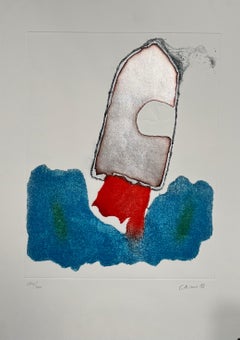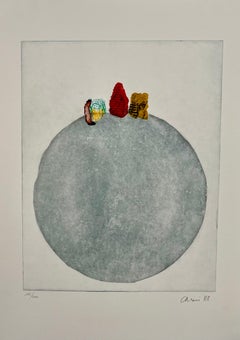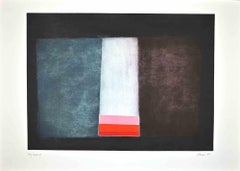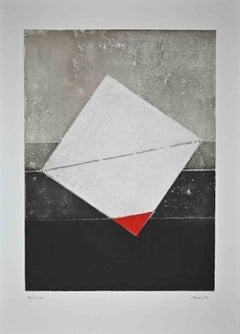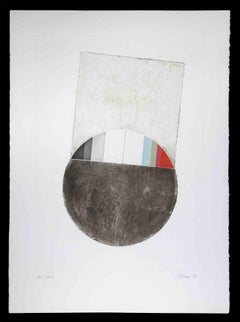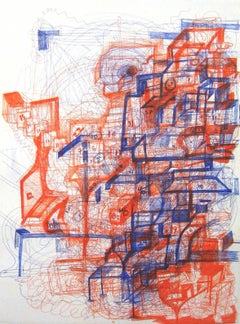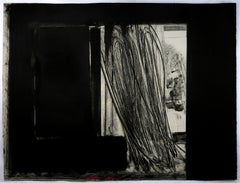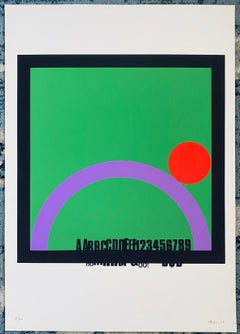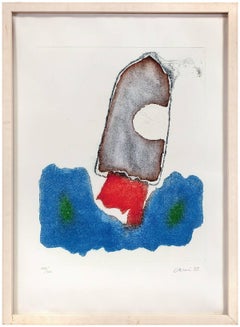Eugenio Carmi Art
to
11
Overall Width
to
Overall Height
to
11
11
3
1
1
9
2
10
6
1
13
8,816
2,808
1,655
1,313
7
4
Artist: Eugenio Carmi
Italian Abstract Aquatint Collage Lithograph Print Eugenio Carmi 80s Memphis Era
By Eugenio Carmi
Located in Surfside, FL
Genre: Modern, Modernist
Subject: Abstract
Medium: Print, Aquatint with metal foil
Hand signed dated 1988, limited edition
Surface: Paper
Country: Italy
Dimensions: 26" x 20" approxi...
Category
1980s Post-Modern Eugenio Carmi Art
Materials
Aquatint
Italian Abstract Aquatint Collage Lithograph Print Eugenio Carmi 80s Memphis Era
By Eugenio Carmi
Located in Surfside, FL
Genre: Modern, Modernist
Subject: Abstract
Medium: Print, Aquatint
Hand signed dated 1988, limited edition
Surface: Paper
Country: Italy
Dimensions: 26" x 20" approximately
Eugenio ...
Category
1980s Post-Modern Eugenio Carmi Art
Materials
Aquatint
Abstract Composition - Etching by Eugenio Carmi - 1987
By Eugenio Carmi
Located in Roma, IT
Abstract Composition is an original etching made by Eugenio Carmi (Genoa, 1920 - Lugano, 2016) in 1987.
Good conditions.
Hand signed and numbered. Edition, VIII/XXXV.
Eugenio Carm...
Category
1980s Abstract Eugenio Carmi Art
Materials
Etching
Abstract Composition - Etching by Eugenio Carmi - 1987
By Eugenio Carmi
Located in Roma, IT
Abstract Compositionis an original etching made by Eugenio Carmi (Genoa, 1920 - Lugano, 2016) in 1987.
Good conditions.
Hand signed and numbered. Edition, VIII/XXXV.
Eugenio Carmi...
Category
1980s Abstract Eugenio Carmi Art
Materials
Etching
Abstract Composition - Etching by Eugenio Carmi - 1983
By Eugenio Carmi
Located in Roma, IT
Abstract Composition is an original etching realized in the 1960s by Eugenio Carmi (Genoa, February 17, 1920 - Lugano, February 16, 2016).
Hand-signed and dated in pencil on the lo...
Category
1980s Surrealist Eugenio Carmi Art
Materials
Etching
Abstract Composition - Etching by Eugenio Carmi - 1987
By Eugenio Carmi
Located in Roma, IT
Abstract Composition is an original etching realized by Eugenio Carmi in 1987.
Good conditions
Numbered. Edition, VIII/XXXV.
The artwork is depicted in a well-balanced composition.
Category
1980s Abstract Eugenio Carmi Art
Materials
Etching
Italian Artist Modern Silkscreen Eugenio Carmi
By Eugenio Carmi
Located in Surfside, FL
Eugenio Carmi is an Italian painter born in 1920 in Genoa. He studied in Turin in Felice Casorati’s studio. His experience as a graphic designer in the ‘50s, is decisive for his pict...
Category
1980s Modern Eugenio Carmi Art
Materials
Screen
Italian Abstract Aquatint Collage Lithograph Print Eugenio Carmi 80s Memphis Era
By Eugenio Carmi
Located in Surfside, FL
Genre: Modern, Modernist
Subject: Abstract
Medium: Print, Aquatint with metal foil
Hand signed dated 1988, limited edition
Surface: Paper
Country: Italy
Dimensions: 26" x 20" approxi...
Category
1980s Post-Modern Eugenio Carmi Art
Materials
Aquatint
Italian Abstract Aquatint Collage Lithograph Print Eugenio Carmi 80s Memphis Era
By Eugenio Carmi
Located in Surfside, FL
Genre: Modern, Modernist
Subject: Abstract
Medium: Print, Aquatint
Hand signed dated 1988, limited edition
Surface: Paper
Country: Italy
Dimensions: 26" x 20" approximately
Eugenio ...
Category
1980s Post-Modern Eugenio Carmi Art
Materials
Aquatint
Italian Abstract Aquatint Collage Lithograph Print Eugenio Carmi 80s Memphis Era
By Eugenio Carmi
Located in Surfside, FL
Genre: Modern, Modernist
Subject: Abstract
Medium: Print, Aquatint
Hand signed dated 1988, limited edition
Surface: Paper
Country: Italy
Dimensions: 26" x 20" approximately
Eugenio ...
Category
1980s Post-Modern Eugenio Carmi Art
Materials
Aquatint
Italian Abstract Aquatint Collage Lithograph Print Eugenio Carmi 80s Memphis Era
By Eugenio Carmi
Located in Surfside, FL
Genre: Modern, Modernist
Subject: Abstract
Medium: Print, Aquatint
Hand signed dated 1988, limited edition
Surface: Paper
Country: Italy
Dimensions: 26" x 20" approximately
Eugenio ...
Category
1980s Post-Modern Eugenio Carmi Art
Materials
Aquatint
Related Items
Untitled
By Joanne Greenbaum
Located in New York, NY
Joanne Greenbaum’s prints are an energetic profusion of overlapping techniques and colors, featuring clusters of architectural forms, irregular shapes, and doodle-like lines. Greenba...
Category
20th Century Abstract Eugenio Carmi Art
Materials
Etching
Howard Hodgkin hand-colored Early Evening in the Museum of Modern Art
By Howard Hodgkin
Located in New York, NY
Large scale black and white abstract interior scene with dots, lines, brushstrokes, and hand painting in grey, to hang in contemporary, modern and minimalist spaces. While British pop artists such as David Hockney and Patrick Caulfield numbered amongst Howard Hodgkin's circle of friends, Hodgkin's work is painterly, emotional, expressionist, and abstract.
Early Evening in the Museum of Modern Art, by Howard Hodgkin. Signed by the artist, numbered, and dated 79 lower center in red crayon. Soft-ground etching printed from the same plate as 'Late Afternoon in the Museum of Modern Art', with hand coloring in black gouache on Grey BFK Rives mould-made paper.
This print depicts an abstracted scene, perhaps a sculpture in front of a window in the Museum of Modern Art, Oxford, in Hodgkin's signature painterly style. The expressive mark-making in this print is an example of the artist’s movement in the late 70s towards pronounced gestures. Wide areas of deep black pigment contrast urgent swipes of ink. Always seeking greater richness in his prints, Hodgkin layered ink and hand coloring in this print, rendering each impression in the edition unique.
Part of a series of four prints reflecting on a visit to...
Category
Late 20th Century Abstract Eugenio Carmi Art
Materials
Gouache, Etching
$2,250
H 29.5 in W 38.75 in
Vintage Abstract Figurative Etching -- "Embrace"
By Patricia Way
Located in Soquel, CA
Vintage abstract figural "Embrace", a lithograph by Patricia Ann Way (American, 20th Century). Signed "Patricia Way" and dated "76" lower right. Slight crease to lower center and s...
Category
1970s Abstract Expressionist Eugenio Carmi Art
Materials
Paper, Ink, Etching
Movement, Abstract Expressionist Etching by Robert Savoie
By Robert Savoie
Located in Long Island City, NY
Robert Savoie, Canadian (1939 - ) - Movement, Year: 1978, Medium: Etching and Aquatint on Arches, signed, dated and numbered in pencil, Edition: 15/50, Image Size: 22 x 27.5 inches, ...
Category
1970s Abstract Expressionist Eugenio Carmi Art
Materials
Etching, Aquatint
$1,200
H 29.5 in W 36.5 in
The corridor of Katmandu, from The Hippies
By Salvador Dalí
Located in Washington, DC
Artist: Salvador Dali
Title: The corridor of Katmandu
Portfolio: The Hippies
Medium: Etching on Arches wove paper
Date: 1969
Edition: Unnumbered proof
Frame Size: 34 1/4" x 27 1/2"
S...
Category
1960s Surrealist Eugenio Carmi Art
Materials
Etching
Marc Chagall - The Candlestick - Original Lithograph
By Marc Chagall
Located in Collonge Bellerive, Geneve, CH
The Candlestick, from Jean Leymarie, Vitraux pour Jérusalem (Jerusalem Windows), André Sauret, Monte Carlo, 1962 (see M. 366-72; see C. books ...
Category
1960s Surrealist Eugenio Carmi Art
Materials
Lithograph
$2,489
H 12.8 in W 9.65 in D 0.04 in
Presenza Grafica
By Alexander Calder
Located in New York, NY
Large, scarce limited edition color aquatint by Alexander Calder, from a limited edition of 90. Signed by Calder and numbered in pencil. Printed and published by 2RC Edizioni d'Art...
Category
1970s Abstract Eugenio Carmi Art
Materials
Aquatint
"More Points on a Bachelor's Tie, " Etching & Aquatint signed
By James Rosenquist
Located in Milwaukee, WI
This is an abstract etching and aquatint by American artist James Rosenquist with colorful red, blue, green, and yellow shapes. It is signed and dated in pencil. Edition 57/78
17 3/...
Category
1970s Abstract Eugenio Carmi Art
Materials
Etching, Aquatint
$11,500
H 28 in W 45 in
"Omniverso" Omniverse - contemporary, surrealist, graphic, geometric sun print
By Pedro Friedeberg
Located in Ciudad de México, MX
The repetition of patterns and rhythm is present in almost every piece of Pedro´s work.
The hybrid topographies that Pedro Friedeberg´s unclassifiable practice recreates we must rec...
Category
21st Century and Contemporary Surrealist Eugenio Carmi Art
Materials
Digital
Marc Chagall - The Red Rider - Original Lithograph
By Marc Chagall
Located in Collonge Bellerive, Geneve, CH
Marc Chagall - Original Lithograph
The Red Rider
From the unsigned, unnumbered lithograph printed in the literary review XXe Siecle
1957
See Mourlot 191
Dimensions: 32 x 24 cm
Publisher: G. di San Lazzaro.
Marc Chagall (born in 1887)
Marc Chagall was born in Belarus in 1887 and developed an early interest in art. After studying painting, in 1907 he left Russia for Paris, where he lived in an artist colony on the city’s outskirts. Fusing his own personal, dreamlike imagery with hints of the fauvism and cubism popular in France at the time, Chagall created his most lasting work—including I and the Village (1911)—some of which would be featured in the Salon des Indépendants exhibitions. After returning to Vitebsk for a visit in 1914, the outbreak of WWI trapped Chagall in Russia. He returned to France in 1923 but was forced to flee the country and Nazi persecution during WWII. Finding asylum in the U.S., Chagall became involved in set and costume design before returning to France in 1948. In his later years, he experimented with new art forms and was commissioned to produce numerous large-scale works. Chagall died in St.-Paul-de-Vence in 1985.
The Village
Marc Chagall was born in a small Hassidic community on the outskirts of Vitebsk, Belarus, on July 7, 1887. His father was a fishmonger, and his mother ran a small sundries shop in the village. As a child, Chagall attended the Jewish elementary school, where he studied Hebrew and the Bible, before later attending the Russian public school. He began to learn the fundamentals of drawing during this time, but perhaps more importantly, he absorbed the world around him, storing away the imagery and themes that would feature largely in most of his later work.
At age 19 Chagall enrolled at a private, all-Jewish art school and began his formal education in painting, studying briefly with portrait artist Yehuda Pen. However, he left the school after several months, moving to St. Petersburg in 1907 to study at the Imperial Society for the Protection of Fine Arts. The following year, he enrolled at the Svanseva School, studying with set designer Léon Bakst, whose work had been featured in Sergei Diaghilev's Ballets Russes. This early experience would prove important to Chagall’s later career as well.
Despite this formal instruction, and the widespread popularity of realism in Russia at the time, Chagall was already establishing his own personal style, which featured a more dreamlike unreality and the people, places and imagery that were close to his heart. Some examples from this period are his Window Vitebsk (1908) and My Fianceé with Black Gloves (1909), which pictured Bella Rosenfeld, to whom he had recently become engaged.
The Beehive
Despite his romance with Bella, in 1911 an allowance from Russian parliament member and art patron Maxim Binaver enabled Chagall to move to Paris, France. After settling briefly in the Montparnasse neighborhood, Chagall moved further afield to an artist colony known as La Ruche (“The Beehive”), where he began to work side by side with abstract painters such as Amedeo Modigliani and Fernand Léger as well as the avant-garde poet Guillaume Apollinaire. At their urging, and under the influence of the wildly popular fauvism and cubism, Chagall lightened his palette and pushed his style ever further from reality. I and the Village (1911) and Homage to Apollinaire (1912) are among his early Parisian works, widely considered to be his most successful and representative period.
Though his work stood stylistically apart from his cubist contemporaries, from 1912 to 1914 Chagall exhibited several paintings at the annual Salon des Indépendants exhibition, where works by the likes of Juan Gris, Marcel Duchamp and Robert Delaunay were causing a stir in the Paris art world. Chagall’s popularity began to spread beyond La Ruche, and in May 1914 he traveled to Berlin to help organize his first solo exhibition, at Der Sturm Gallery. Chagall remained in the city until the highly acclaimed show opened that June. He then returned to Vitebsk, unaware of the fateful events to come.
War, Peace and Revolution
In August 1914 the outbreak of World War I precluded Chagall’s plans to return to Paris. The conflict did little to stem the flow of his creative output, however, instead merely giving him direct access to the childhood scenes so essential to his work, as seen in paintings such as Jew in Green (1914) and Over Vitebsk (1914). His paintings from this period also occasionally featured images of the war’s impact on the region, as with Wounded Soldier (1914) and Marching (1915). But despite the hardships of life during wartime, this would also prove to be a joyful period for Chagall. In July 1915 he married Bella, and she gave birth to a daughter, Ida, the following year. Their appearance in works such as Birthday (1915), Bella and Ida by the Window (1917) and several of his “Lovers” paintings give a glimpse of the island of domestic bliss that was Chagall’s amidst the chaos.
To avoid military service and stay with his new family, Chagall took a position as a clerk in the Ministry of War Economy in St. Petersburg. While there he began work on his autobiography and also immersed himself in the local art scene, befriending novelist Boris Pasternak, among others. He also exhibited his work in the city and soon gained considerable recognition. That notoriety would prove important in the aftermath of the 1917 Russian Revolution when he was appointed as the Commissar of Fine Arts in Vitebsk. In his new post, Chagall undertook various projects in the region, including the 1919 founding of the Academy of the Arts. Despite these endeavors, differences among his colleagues eventually disillusioned Chagall. In 1920 he relinquished his position and moved his family to Moscow, the post-revolution capital of Russia.
In Moscow, Chagall was soon commissioned to create sets and costumes for various productions at the Moscow State Yiddish Theater, where he would paint a series of murals titled Introduction to the Jewish Theater as well. In 1921, Chagall also found work as a teacher at a school for war orphans. By 1922, however, Chagall found that his art had fallen out of favor, and seeking new horizons he left Russia for good.
Flight
After a brief stay in Berlin, where he unsuccessfully sought to recover the work exhibited at Der Sturm before the war, Chagall moved his family to Paris in September 1923. Shortly after their arrival, he was commissioned by art dealer and publisher Ambroise Vollard to produce a series of etchings for a new edition of Nikolai Gogol's 1842 novel Dead Souls. Two years later Chagall began work on an illustrated edition of Jean de la Fontaine’s Fables, and in 1930 he created etchings for an illustrated edition of the Old Testament, for which he traveled to Palestine to conduct research.
Chagall’s work during this period brought him new success as an artist and enabled him to travel throughout Europe in the 1930s. He also published his autobiography, My Life (1931), and in 1933 received a retrospective at the Kunsthalle in Basel, Switzerland. But at the same time that Chagall’s popularity was spreading, so, too, was the threat of Fascism and Nazism. Singled out during the cultural "cleansing" undertaken by the Nazis in Germany, Chagall’s work was ordered removed from museums throughout the country. Several pieces were subsequently burned, and others were featured in a 1937 exhibition of “degenerate art” held in Munich. Chagall’s angst regarding these troubling events and the persecution of Jews in general can be seen in his 1938 painting White Crucifixion.
With the eruption of World War II, Chagall and his family moved to the Loire region before moving farther south to Marseilles following the invasion of France. They found a more certain refuge when, in 1941, Chagall’s name was added by the director of the Museum of Modern Art (MOMA) in New York City to a list of artists and intellectuals deemed most at risk from the Nazis’ anti-Jewish campaign. Chagall and his family would be among the more than 2,000 who received visas and escaped this way.
Haunted Harbors
Arriving in New York City in June 1941, Chagall discovered that he was already a well-known artist there and, despite a language barrier, soon became a part of the exiled European artist community. The following year he was commissioned by choreographer Léonide Massine to design sets and costumes for the ballet Aleko, based on Alexander Pushkin’s “The Gypsies” and set to the music of Pyotr Ilyich Tchaikovsky.
But even as he settled into the safety of his temporary home, Chagall’s thoughts were frequently consumed by the fate befalling the Jews of Europe and the destruction of Russia, as paintings such as The Yellow Crucifixion...
Category
1950s Surrealist Eugenio Carmi Art
Materials
Lithograph
$2,904
H 12.6 in W 9.45 in D 0.04 in
Marc Chagall - Inspiration - Original Lithograph from "Chagall Lithographe" v. 2
By Marc Chagall
Located in Collonge Bellerive, Geneve, CH
Marc Chagall
Original Lithograph from Chagall Lithographe 1957-1962. VOLUME II.
1963
Dimensions: 32 x 24 cm
From the unsigned edition of 10000 copies without margins
Reference: Mourlot 398
Condition : Excellent
Marc Chagall (born in 1887)
Marc Chagall was born in Belarus in 1887 and developed an early interest in art. After studying painting, in 1907 he left Russia for Paris, where he lived in an artist colony on the city’s outskirts. Fusing his own personal, dreamlike imagery with hints of the fauvism and cubism popular in France at the time, Chagall created his most lasting work—including I and the Village (1911)—some of which would be featured in the Salon des Indépendants exhibitions. After returning to Vitebsk for a visit in 1914, the outbreak of WWI trapped Chagall in Russia. He returned to France in 1923 but was forced to flee the country and Nazi persecution during WWII. Finding asylum in the U.S., Chagall became involved in set and costume design before returning to France in 1948. In his later years, he experimented with new art forms and was commissioned to produce numerous large-scale works. Chagall died in St.-Paul-de-Vence in 1985.
The Village
Marc Chagall was born in a small Hassidic community on the outskirts of Vitebsk, Belarus, on July 7, 1887. His father was a fishmonger, and his mother ran a small sundries shop in the village. As a child, Chagall attended the Jewish elementary school, where he studied Hebrew and the Bible, before later attending the Russian public school. He began to learn the fundamentals of drawing during this time, but perhaps more importantly, he absorbed the world around him, storing away the imagery and themes that would feature largely in most of his later work.
At age 19 Chagall enrolled at a private, all-Jewish art school and began his formal education in painting, studying briefly with portrait artist Yehuda Pen. However, he left the school after several months, moving to St. Petersburg in 1907 to study at the Imperial Society for the Protection of Fine Arts. The following year, he enrolled at the Svanseva School, studying with set designer Léon Bakst, whose work had been featured in Sergei Diaghilev's Ballets Russes. This early experience would prove important to Chagall’s later career as well.
Despite this formal instruction, and the widespread popularity of realism in Russia at the time, Chagall was already establishing his own personal style, which featured a more dreamlike unreality and the people, places and imagery that were close to his heart. Some examples from this period are his Window Vitebsk (1908) and My Fianceé with Black Gloves (1909), which pictured Bella Rosenfeld, to whom he had recently become engaged.
The Beehive
Despite his romance with Bella, in 1911 an allowance from Russian parliament member and art patron Maxim Binaver enabled Chagall to move to Paris, France. After settling briefly in the Montparnasse neighborhood, Chagall moved further afield to an artist colony known as La Ruche (“The Beehive”), where he began to work side by side with abstract painters such as Amedeo Modigliani and Fernand Léger as well as the avant-garde poet Guillaume Apollinaire. At their urging, and under the influence of the wildly popular fauvism and cubism, Chagall lightened his palette and pushed his style ever further from reality. I and the Village (1911) and Homage to Apollinaire (1912) are among his early Parisian works, widely considered to be his most successful and representative period.
Though his work stood stylistically apart from his cubist contemporaries, from 1912 to 1914 Chagall exhibited several paintings at the annual Salon des Indépendants exhibition, where works by the likes of Juan Gris, Marcel Duchamp and Robert Delaunay were causing a stir in the Paris art world. Chagall’s popularity began to spread beyond La Ruche, and in May 1914 he traveled to Berlin to help organize his first solo exhibition, at Der Sturm Gallery. Chagall remained in the city until the highly acclaimed show opened that June. He then returned to Vitebsk, unaware of the fateful events to come.
War, Peace and Revolution
In August 1914 the outbreak of World War I precluded Chagall’s plans to return to Paris. The conflict did little to stem the flow of his creative output, however, instead merely giving him direct access to the childhood scenes so essential to his work, as seen in paintings such as Jew in Green (1914) and Over Vitebsk (1914). His paintings from this period also occasionally featured images of the war’s impact on the region, as with Wounded Soldier (1914) and Marching (1915). But despite the hardships of life during wartime, this would also prove to be a joyful period for Chagall. In July 1915 he married Bella, and she gave birth to a daughter, Ida, the following year. Their appearance in works such as Birthday (1915), Bella and Ida by the Window (1917) and several of his “Lovers” paintings give a glimpse of the island of domestic bliss that was Chagall’s amidst the chaos.
To avoid military service and stay with his new family, Chagall took a position as a clerk in the Ministry of War Economy in St. Petersburg. While there he began work on his autobiography and also immersed himself in the local art scene, befriending novelist Boris Pasternak, among others. He also exhibited his work in the city and soon gained considerable recognition. That notoriety would prove important in the aftermath of the 1917 Russian Revolution when he was appointed as the Commissar of Fine Arts in Vitebsk. In his new post, Chagall undertook various projects in the region, including the 1919 founding of the Academy of the Arts. Despite these endeavors, differences among his colleagues eventually disillusioned Chagall. In 1920 he relinquished his position and moved his family to Moscow, the post-revolution capital of Russia.
In Moscow, Chagall was soon commissioned to create sets and costumes for various productions at the Moscow State Yiddish Theater...
Category
1960s Surrealist Eugenio Carmi Art
Materials
Lithograph
$1,482
H 9.45 in W 12.6 in D 0.04 in
Methuselah - Etchings by Brian Eno, 2023, Etching on Somerset Velvet 400gsm
By Brian Eno
Located in Zug, CH
Brian Eno
Methuselah Etchings
2023
Etching on Somerset Velvet 400gsm, with deckled edges
65.5 × 65.5 cm
(25.8 × 25.8 in)
Signed and numbered
Edition of 25
In excellent conditions
P...
Category
2010s Abstract Eugenio Carmi Art
Materials
Etching
$3,082 Sale Price
20% Off
H 25.79 in W 25.79 in
Previously Available Items
Italian Artist Modern Silkscreen Eugenio Carmi
By Eugenio Carmi
Located in Surfside, FL
Eugenio Carmi is an Italian painter born in 1920 in Genoa. He studied in Turin in Felice Casorati’s studio. His experience as a graphic designer in the ‘50s, is decisive for his pictorial research, based on a rigorous geometrical structure and on a fine analysis of the perception of colors.
He participated in the Venice Biennale in 1966.
In 1967 he showed some electronic works in the Superlund exhibition organized by Pierre Restany in Lund, Sweden.
In 1968, he introduced the “Carm-o-matic”, during the Cybernetic Serendipity show at the Institute of Contemporary Art in London.
In 1973, he produced an entirely abstract 25-minute show for RAI’s Experimental Programs Service. The same year, he taught visual art seminars at the Rhode Island Institute of Design in the United States.
In the ‘70s, he gave courses at the Accademia of Macerata and at the Accademia of Ravenna (Italy).
He produced illustrations for three of Umberto Eco’s stories, published in Italy by Bompiani and in many other countries. The French Ministry of Education has selected them for libraries and schools in France.
The most important retrospective of his work was organized by the Milan town hall in 1990, followed by a prestigious exhibition in Budapest, in the halls of the Royal Palace, in 1992.
In 1991 he exhibited at the San Francisco Italian American Museum.
In 1996 the “Carmi” book is published by Umberto Eco and Duncan Macmillan and presented at the Milan Triennial: a synthesis of his life.
From 1957 to 1965 he will play the role of artistic director of Cornigliano's corporate magazine.
During this time iron and steel are materials that Carmi meets every day and become a strong creative stimulus for him. In his first solo exhibition - presented by Gillo Dorfles in 1958 at the Galleria Numero di Firenze - the protagonists are the enamels on steel and since 1960 he made various iron and steel works welded and lithographed milk.
Iron and steel is the work that in 1962 presented at Spoleto Sculpture exhibition in the city , organized by Giovanni Carandente under the V Festival of the Two Worlds .
In this period, he is involved not only in the cultural politics of the Istallier ( Victor Vasarely , Umberto Eco , Max Bill , Konrad Wachsmann , Furio Colombo , Ugo Mulas , Kurt Blum , Emanuele Luzzati , Flavio Costantini ) , But also in the cultural activity of the Warehouse Gallery , which Carmi founded in Boccadasse in 1963. The Warehouse Gallery with multiples intends to propose a serial art accessible to a wider audience and is placed in international discussions on 'Multiplied Art, representing one of the most important examples.
The friendship and mutual esteem that binds him to Umberto Eco has two very important fruits at this time: Children's Fables and Stripsody . In 1966 for the publishing house Bompiani came three Eco fables illustrated by Carmi and then re-introduced in 1988 with new Carmi illustrations and a fable more. Stripsody is a musical project on cartoon sound, designed and then interpreted by the genius singer Cathy Berberian, with Eco texts and illustrations by Carmi.
Eugenio Carmi, who is always fascinated by the new technological possibilities in the 1960s and 1970s, is the author of experimental cinematic and audiovisual artwork and also realizes those who will call electrical imagery signals that will also be at the center of a provocative installation on the streets of the city of Caorle .
It is at this stage that in 1966 he was at the XXXIII edition of the Venice Biennale with the electronic work SPCE (electronically controlled polycyclic structure), which is also the invitation of Pierre Restany to participate with electronic works at the SuperLund exhibition in Sweden.
In 1971, he moved to Milan with his family, where he established his study.
At this point, though with incursions in other parallel fields such as the realization of mirrors and stained glass, painting, and sporadically sculpture - which had approached the Istal period - is at the center of its activity. It is at the beginning of the seventies that it deepens the geometric language, already open with some previous experiences (accident prevention signs for the Italsider, some multiples for the Deposit and electrical imagery signals), replacing it with the informal one.
In 1979 he produced a magazine - which will remain the same number - by the name of Res Publica , for which he receives the contributions of intellectuals and artists, including Umberto Eco, Antonio Porta , Gillo Dorfles , Richard Paul Lohse...
Category
1980s Modern Eugenio Carmi Art
Materials
Screen
Abstract Composition Aquatint collage
By Eugenio Carmi
Located in Surfside, FL
Genre: Modern
Subject: Abstract
Medium: Print, Aquatint
Surface: Paper
Country: United States
Dimensions w/Frame: 26" x 19"
Eugenio Carmi is an Italian painter born in 1920 in Genoa. He studied in Turin in Felice Casorati’s studio. His experience as a graphic designer in the ‘50s, is decisive for his pictorial research, based on a rigorous geometrical structure and on a fine analysis of the perception of colors.
He participated in the Venice Biennale in 1966.
In 1967 he showed some electronic works in the Superlund exhibition organized by Pierre Restany in Lund, Sweden.
In 1968, he introduced the “Carm-o-matic”, during the Cybernetic Serendipity show at the Institute of Contemporary Art in London.
In 1973, he produced an entirely abstract 25-minute show for RAI’s Experimental Programs Service. The same year, he taught visual art seminars at the Rhode Island Institute of Design in the United States.
In the ‘70s, he gave courses at the Accademia of Macerata and at the Accademia of Ravenna (Italy).
He produced illustrations for three of Umberto Eco’s stories, published in Italy by Bompiani and in many other countries. The French Ministry of Education has selected them for libraries and schools in France.
The most important retrospective of his work was organized by the Milan town hall in 1990, followed by a prestigious exhibition in Budapest, in the halls of the Royal Palace, in 1992.
In 1991 he exhibited at the San Francisco Italian American Museum.
In 1996 the “Carmi” book is published by Umberto Eco and Duncan Macmillan and presented at the Milan Triennial: a synthesis of his life.
From 1957 to 1965 he will play the role of artistic director of Cornigliano's corporate magazine.
During this time iron and steel are materials that Carmi meets every day and become a strong creative stimulus for him. In his first solo exhibition - presented by Gillo Dorfles in 1958 at the Galleria Numero di Firenze - the protagonists are the enamels on steel and since 1960 he made various iron and steel works welded and lithographed milk.
Iron and steel is the work that in 1962 presented at Spoleto Sculpture exhibition in the city , organized by Giovanni Carandente under the V Festival of the Two Worlds .
In this period, he is involved not only in the cultural politics of the Istallier ( Victor Vasarely , Umberto Eco , Max Bill , Konrad Wachsmann , Furio Colombo , Ugo Mulas , Kurt Blum , Emanuele Luzzati , Flavio Costantini ) , But also in the cultural activity of the Warehouse Gallery , which Carmi founded in Boccadasse in 1963. The Warehouse Gallery with multiples intends to propose a serial art accessible to a wider audience and is placed in international discussions on 'Multiplied Art, representing one of the most important examples.
The friendship and mutual esteem that binds him to Umberto Eco has two very important fruits at this time: Children's Fables and Stripsody . In 1966 for the publishing house Bompiani came three Eco fables illustrated by Carmi and then re-introduced in 1988 with new Carmi illustrations and a fable more. Stripsody is a musical project on cartoon sound, designed and then interpreted by the genius singer Cathy Berberian, with Eco texts and illustrations by Carmi.
Eugenio Carmi, who is always fascinated by the new technological possibilities in the 1960s and 1970s, is the author of experimental cinematic and audiovisual artwork and also realizes those who will call electrical imagery signals that will also be at the center of a provocative installation on the streets of the city of Caorle .
It is at this stage that in 1966 he was at the XXXIII edition of the Venice Biennale with the electronic work SPCE (electronically controlled polycyclic structure), which is also the invitation of Pierre Restany to participate with electronic works at the SuperLund exhibition in Sweden.
In 1971, he moved to Milan with his family, where he established his study.
At this point, though with incursions in other parallel fields such as the realization of mirrors and stained glass, painting, and sporadically sculpture - which had approached the Istal period - is at the center of its activity. It is at the beginning of the seventies that it deepens the geometric language, already open with some previous experiences (accident prevention signs for the Italsider, some multiples for the Deposit and electrical imagery signals), replacing it with the informal one.
In 1979 he produced a magazine - which will remain the same number - by the name of Res Publica , for which he receives the contributions of intellectuals and artists, including Umberto Eco, Antonio Porta , Gillo Dorfles , Richard Paul Lohse...
Category
1980s Eugenio Carmi Art
Materials
Aquatint
Abstract Composition
By Eugenio Carmi
Located in Surfside, FL
Genre: Modern
Subject: Abstract
Medium: Print, Aquatint
Surface: Paper
Country: United States
Dimensions w/Frame: 26" x 19"
Eugenio Carmi is an Italian painter born in 1920 in Genoa. He studied in Turin in Felice Casorati’s studio. His experience as a graphic designer in the ‘50s, is decisive for his pictorial research, based on a rigorous geometrical structure and on a fine analysis of the perception of colors.
He participated in the Venice Biennale in 1966.
In 1967 he showed some electronic works in the Superlund exhibition organized by Pierre Restany in Lund, Sweden.
In 1968, he introduced the “Carm-o-matic”, during the Cybernetic Serendipity show at the Institute of Contemporary Art in London.
In 1973, he produced an entirely abstract 25-minute show for RAI’s Experimental Programs Service. The same year, he taught visual art seminars at the Rhode Island Institute of Design in the United States.
In the ‘70s, he gave courses at the Accademia of Macerata and at the Accademia of Ravenna (Italy).
He produced illustrations for three of Umberto Eco’s stories, published in Italy by Bompiani and in many other countries. The French Ministry of Education has selected them for libraries and schools in France.
The most important retrospective of his work was organized by the Milan town hall in 1990, followed by a prestigious exhibition in Budapest, in the halls of the Royal Palace, in 1992.
In 1991 he exhibited at the San Francisco Italian American Museum.
In 1996 the “Carmi” book is published by Umberto Eco and Duncan Macmillan and presented at the Milan Triennial: a synthesis of his life.
From 1957 to 1965 he will play the role of artistic director of Cornigliano's corporate magazine.
During this time iron and steel are materials that Carmi meets every day and become a strong creative stimulus for him. In his first solo exhibition - presented by Gillo Dorfles in 1958 at the Galleria Numero di Firenze - the protagonists are the enamels on steel and since 1960 he made various iron and steel works welded and lithographed milk.
Iron and steel is the work that in 1962 presented at Spoleto Sculpture exhibition in the city , organized by Giovanni Carandente under the V Festival of the Two Worlds .
In this period, he is involved not only in the cultural politics of the Istallier ( Victor Vasarely , Umberto Eco , Max Bill , Konrad Wachsmann , Furio Colombo , Ugo Mulas , Kurt Blum , Emanuele Luzzati , Flavio Costantini ) , But also in the cultural activity of the Warehouse Gallery , which Carmi founded in Boccadasse in 1963. The Warehouse Gallery with multiples intends to propose a serial art accessible to a wider audience and is placed in international discussions on 'Multiplied Art, representing one of the most important examples.
The friendship and mutual esteem that binds him to Umberto Eco has two very important fruits at this time: Children's Fables and Stripsody . In 1966 for the publishing house Bompiani came three Eco fables illustrated by Carmi and then re-introduced in 1988 with new Carmi illustrations and a fable more. Stripsody is a musical project on cartoon sound, designed and then interpreted by the genius singer Cathy Berberian, with Eco texts and illustrations by Carmi.
Eugenio Carmi, who is always fascinated by the new technological possibilities in the 1960s and 1970s, is the author of experimental cinematic and audiovisual artwork and also realizes those who will call electrical imagery signals that will also be at the center of a provocative installation on the streets of the city of Caorle .
It is at this stage that in 1966 he was at the XXXIII edition of the Venice Biennale with the electronic work SPCE (electronically controlled polycyclic structure), which is also the invitation of Pierre Restany to participate with electronic works at the SuperLund exhibition in Sweden.
In 1971, he moved to Milan with his family, where he established his study.
At this point, though with incursions in other parallel fields such as the realization of mirrors and stained glass, painting, and sporadically sculpture - which had approached the Istal period - is at the center of its activity. It is at the beginning of the seventies that it deepens the geometric language, already open with some previous experiences (accident prevention signs for the Italsider, some multiples for the Deposit and electrical imagery signals), replacing it with the informal one.
In 1979 he produced a magazine - which will remain the same number - by the name of Res Publica , for which he receives the contributions of intellectuals and artists, including Umberto Eco, Antonio Porta , Gillo Dorfles , Richard Paul Lohse...
Category
1980s Modern Eugenio Carmi Art
Materials
Aquatint
Eugenio Carmi art for sale on 1stDibs.
Find a wide variety of authentic Eugenio Carmi art available for sale on 1stDibs. If you’re browsing the collection of art to introduce a pop of color in a neutral corner of your living room or bedroom, you can find work that includes elements of blue and other colors. You can also browse by medium to find art by Eugenio Carmi in etching, screen print and more. Much of the original work by this artist or collective was created during the 1980s and is mostly associated with the abstract style. Not every interior allows for large Eugenio Carmi art, so small editions measuring 19 inches across are available. Customers who are interested in this artist might also find the work of Riccardo Licata, Renato Barisani, and Mauro Reggiani. Eugenio Carmi art prices can differ depending upon medium, time period and other attributes. On 1stDibs, the price for these items starts at $382 and tops out at $850, while the average work can sell for $512.
